Language Learning Apps and YT Channels: Season 3
This comes as a late update to my previous post from 2021, Language Learning Apps, Revisited: 34 Products + Bonus Links, which in turn was an update to a post from 2017, Learning a language in 200 hours? This time, I want to stress a bit on learning Italian.
An update on the apps
No matter how many apps I’ve listed and tried back then, I still believe a more classical learning approach is a better choice. By this, I mean that one should own and use one or more physical books, preferably with audio support, and preferably one of those old-school methods designed before the retarded Common European Framework of Reference for Languages was born. The CEFRL mandated the creation of language learning methods that:
- Insist on the “discovery” of the language by the students, including of the grammar rules, instead of first defining the rules and the vocabulary.
- The textbooks often aren’t “complete” in describing the grammar, sometimes empty placeholders being left to be filled in the classroom; therefore, if one misses a class, they can’t just learn from the book, which is different from what you have in a “normal” school.
- Don’t differentiate between adults and children, thus having textbooks and activity books that are unappealing to some adults. Frankly, I find most of the exercises plainly retarded, especially those in which one should put some words or text fragments in such an order that the result would have a meaning, which is totally against real life; in real life, one would have two issues and two only: 1. How do I say what I want to say? 2. What are they telling me? In no circumstances does such a situation arise in which one asks themselves, “Well, how do I use some random words to say something that would make sense, no matter what I say?” Guesswork is not helping learning that much—if anything, it pisses me off greatly.
- The textbooks don’t differentiate between students being educated people, less educated people, or retards, therefore they might choose to skip “difficult” grammar terms and concepts, sometimes even terms such as “adverb”! You might not know what you’re learning about!
- The methods are universal in that they don’t target the specificities of a student’s mother tongue. E.g. when someone speaking a Romance language is taught another Romance language, the problem isn’t that the nouns are gendered, but when they come from English, that’s a huge problem. Even when being taught German, with its idiotic Wechselpräpositionen and the exaggerated declensions, I suspect one shouldn’t use the same method for an American, a Swede, a Turk, and a Frenchman.
- Everything is only in the target language from the beginning. This “immersion” thing isn’t something new, but it tends to start abruptly, with lessons whose texts one would barely understand. It’s not like Mauger’s Cours de langue et de civilisation françaises, designed in 1953 and revised in 1967, which indeed is 100% in French, but the first lesson starts with: “un homme, une femme, un garçon, une fille; c’est un livre, c’est un cahier, etc.; Est-ce un banc ? Oui, c’est un banc.”, all with unambigous drawings, and a great logical structure. With lessons based on CEFRL-sanctioned methods, the idea is, “oh, but you don’t have to understand everything you read in a lesson!” Really?
This being said, one or more apps can help people have a smoother start in a foreign language as an adult. From the tested apps, after having revisited and tested them again regarding the very specific task of learning Italian through English (or through French, where available), I decided that the following four apps are the most valuable ones, despite their approaches being different:

- Busuu — learning from English of French (the lessons are identical, they’re just translated from English).
- Duolingo — learning from English or French (the lessons are not the same).
- Memrise — learning from English.
- Mango Languages — from English.
Some new criticism for Duolingo, though: given that several moods and tenses from other languages here, Italian), especially the subjunctive, translate to the infinitive in English, sometimes the questions are totally ridiculous, as in the following examples:
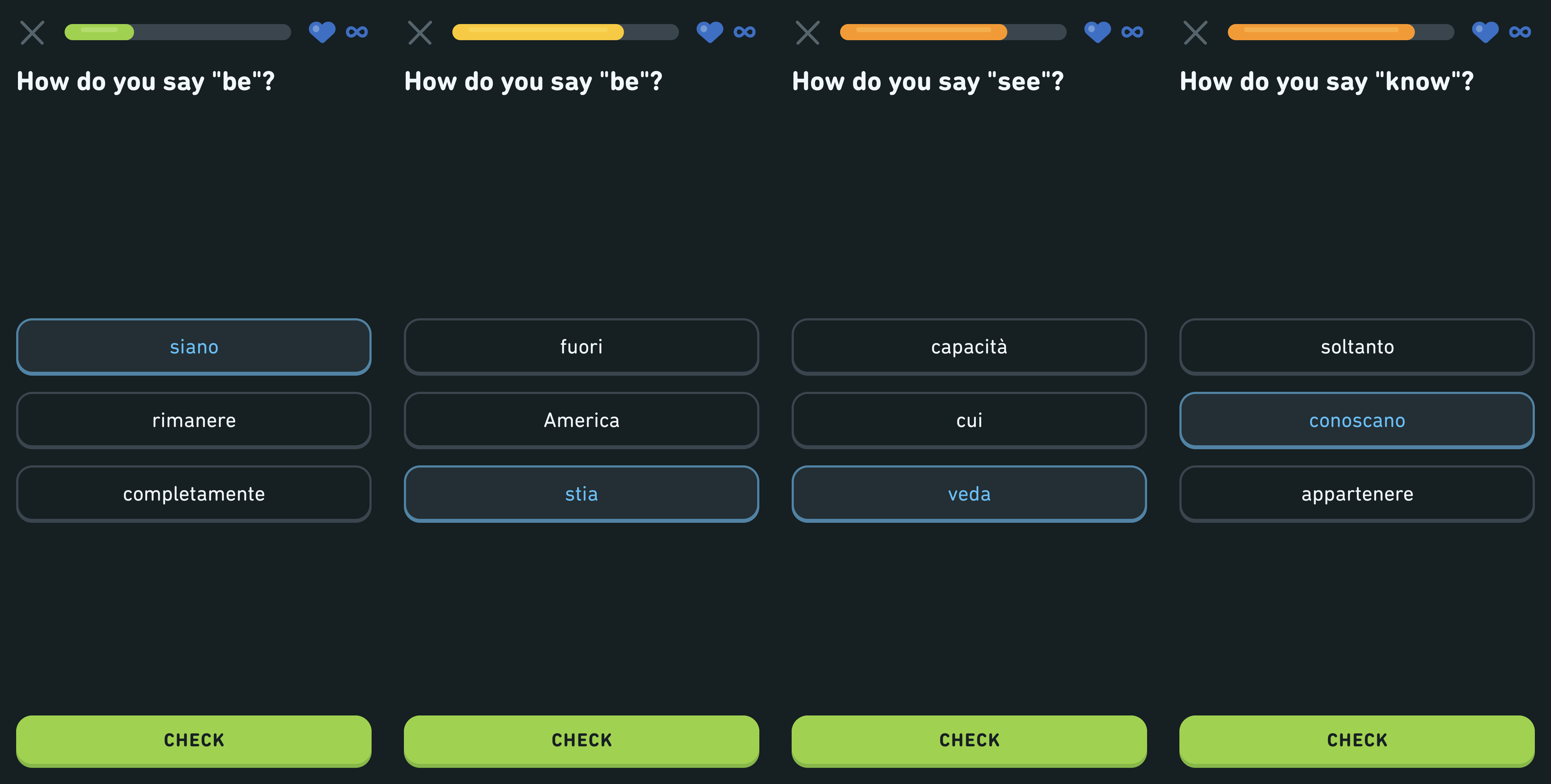
App number 35
Let’s just add one more app to those previously reviewed 34:
🟢🟡🟡🟡🟡 Wlingua
Learn English, Spanish, French, German, Russian, Italian. You can know English, Spanish, Portuguese, Russian, German, Italian; it doesn’t matter, as the lessons are identical regardless of the source language, being just translated. The number of lessons differs from a target language to another: 190 for learning French, 200 for Italian, 200 for German, 500 for English (UK or US), 510 for Russian, 520 for Spanish (Spain or Mexico). That was the official description, probably based on a much older version of the app (the website still shows the same numbers), because the reality shows otherwise: Italian had 350 lessons when I last tried it! Sure thing, the lessons are short and simple—maybe too short, so that the progress is slow. Also, somewhere in the 9th lesson, they wanted me to start paying €9.99/mo, €19.98 quarterly, or €59.99/yr.

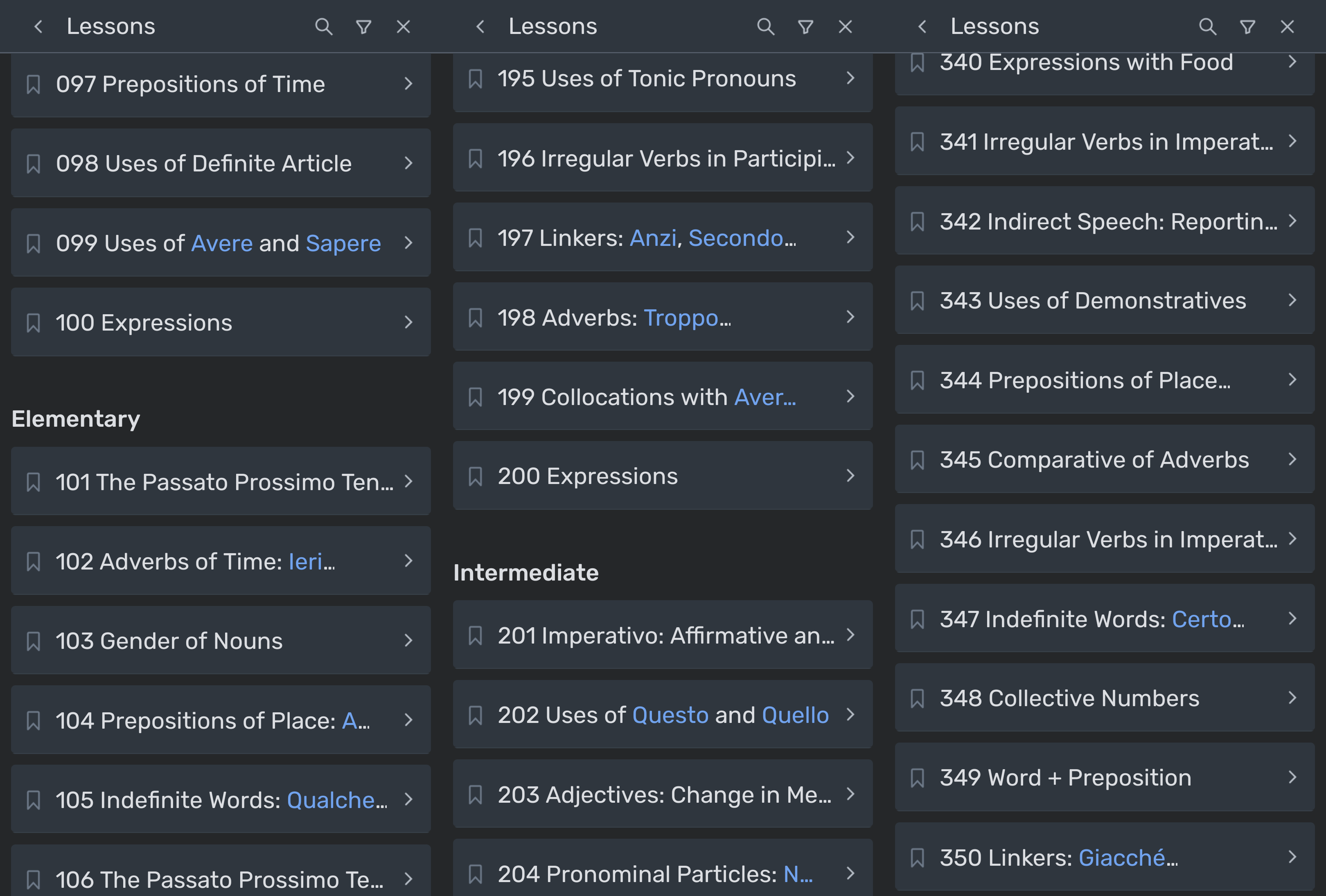
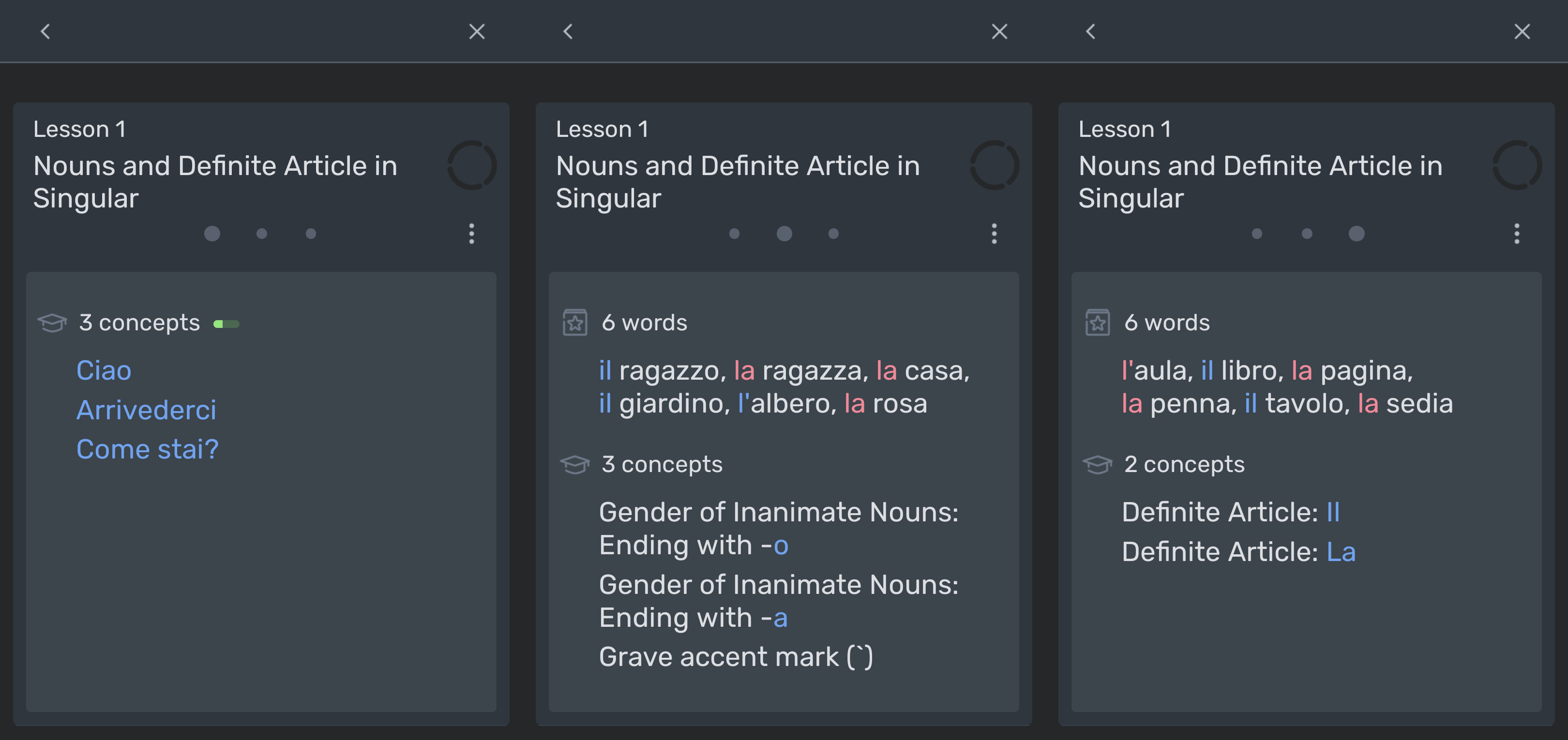
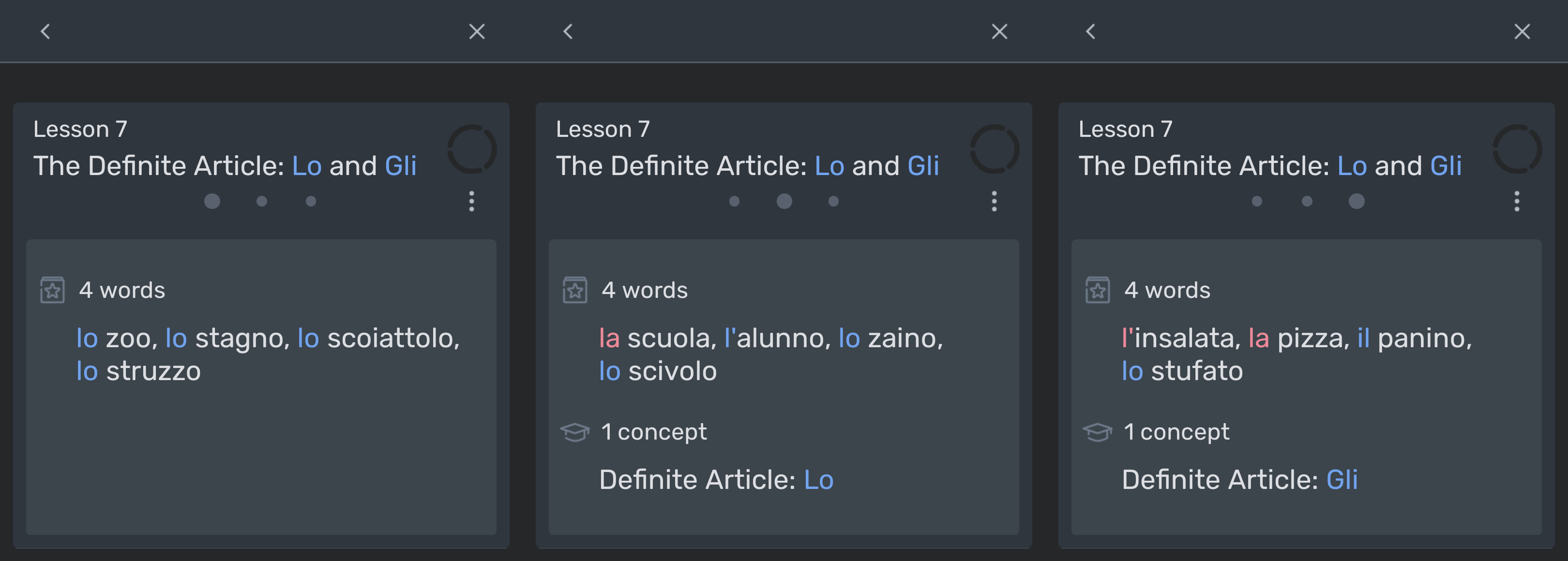

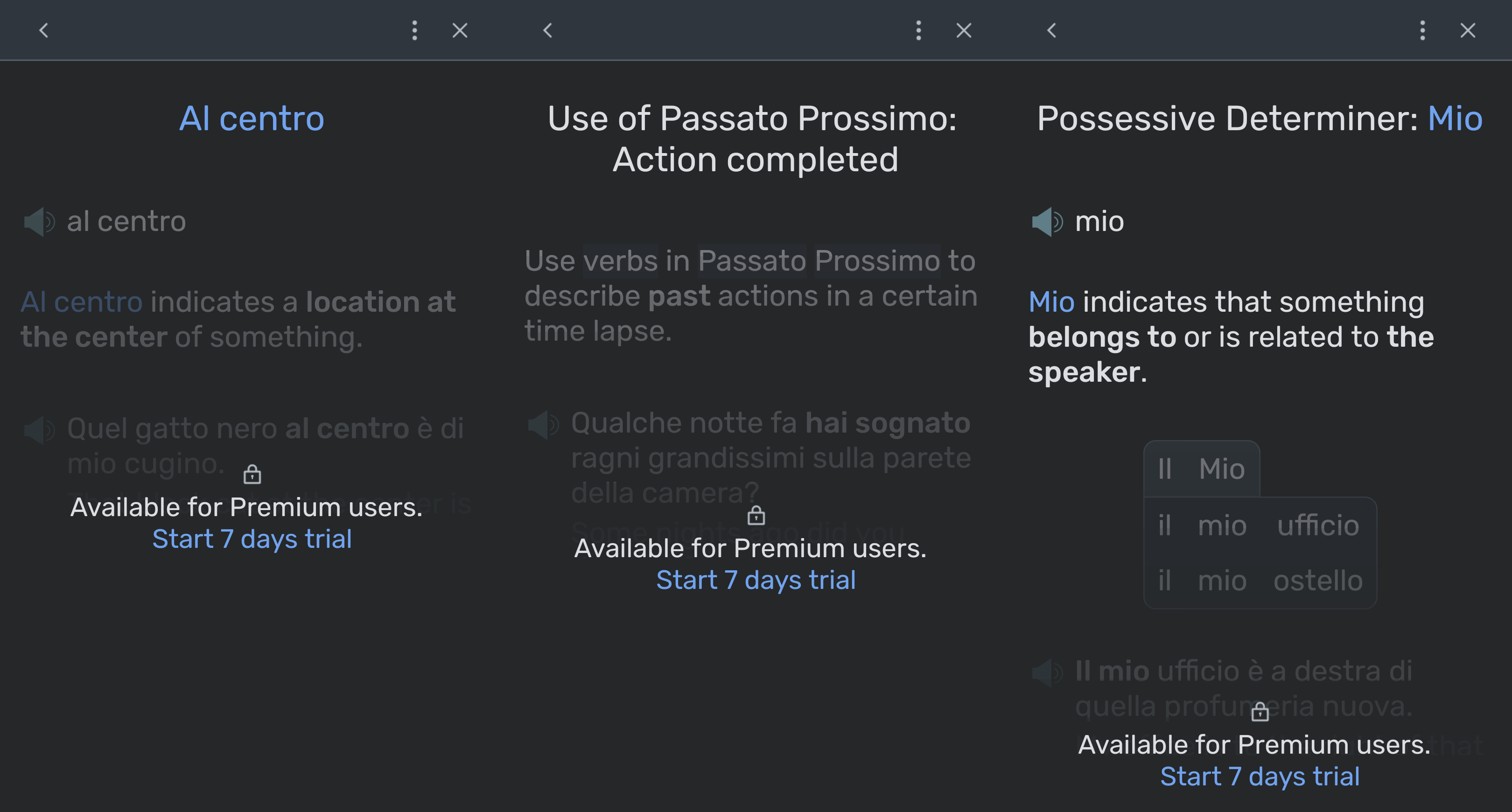
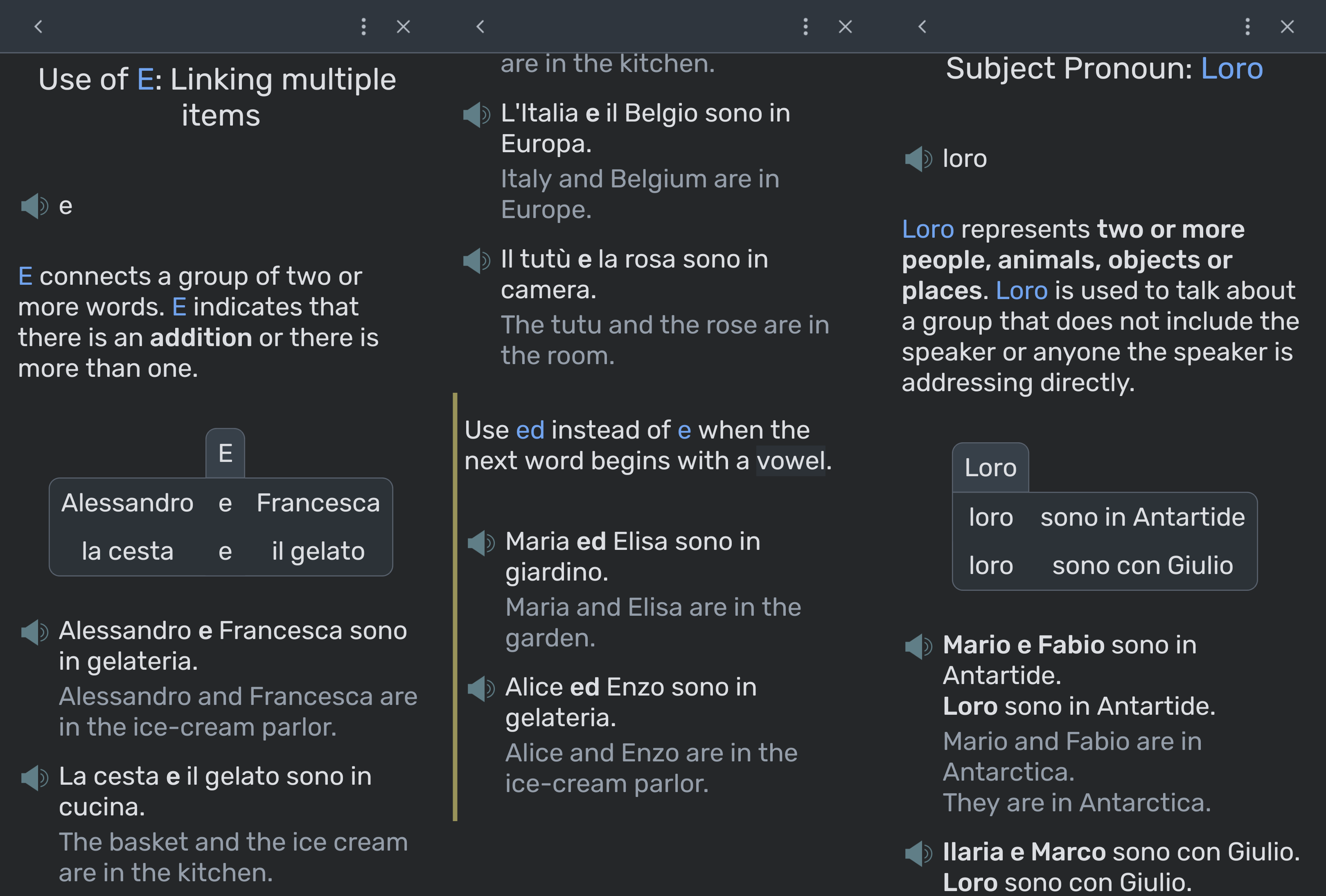
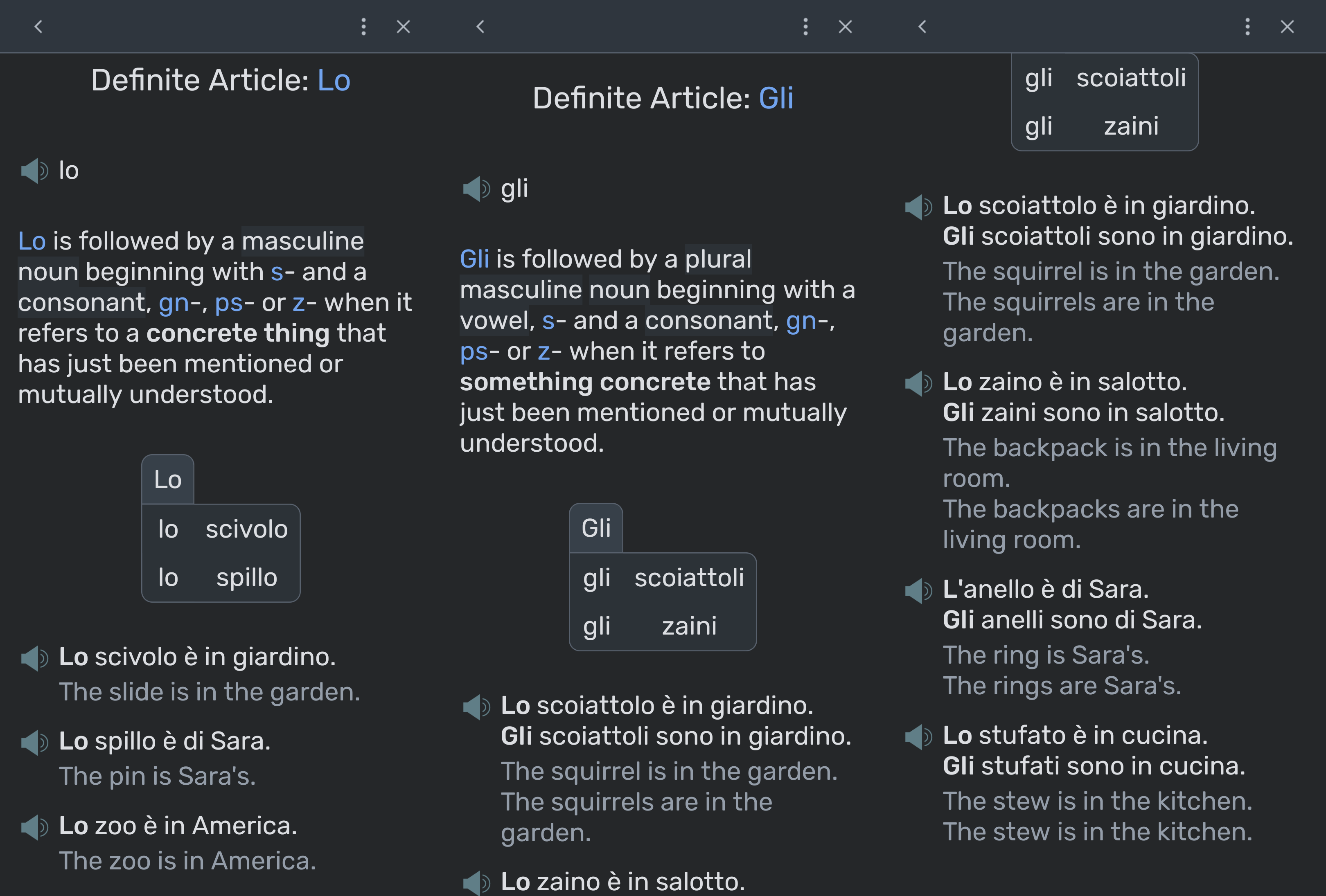
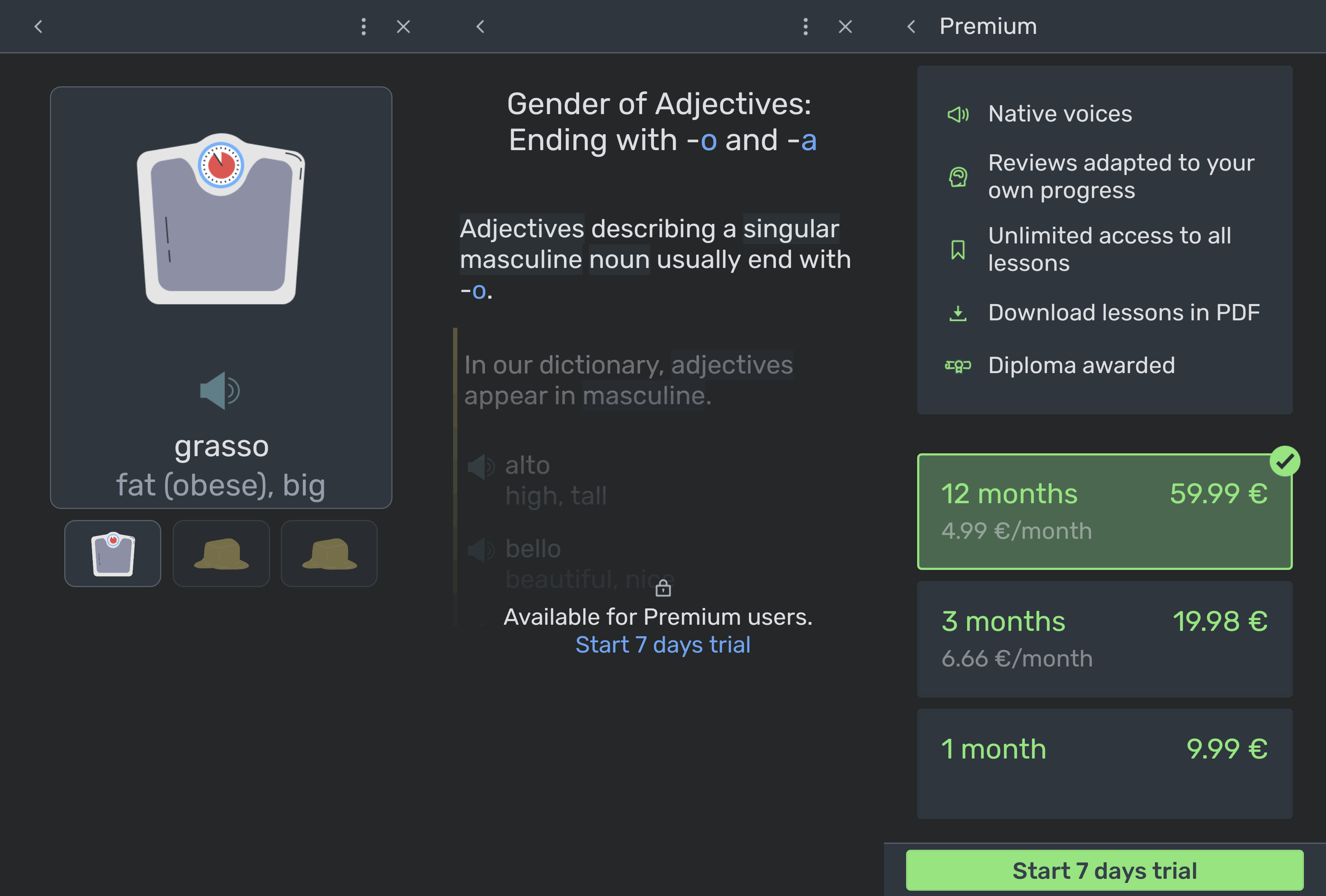
The company is registered in Bilbao, but what I strongly dislike with them is that the exact name of the company isn’t specified; the website reads:
Wlingua has its head office in the street Arbidea 7, 48004 Bilbao CIF B95698379. The company is registered in the trade register of Bilbao as of 28 September 2012, Volume: 5312, Book 0, Folio 144, Page 60975, Entry 1.
Well, OK, but what’s the COMPANY’S NAME registered in that fucking Volume 5312 at page 60975, in the first entry?! I just can’t trust such people!
Bottom line: Promising, but expensive and questionable. Your choice.∎
Updates to the YouTube channels
I already made a couple of updates to the YouTube channels for learning Italian in the original article:
- To LearnAmo — with Graziana Filomeno and Rocco Dabellonio: playlists and a few more selected videos.
- NEW: Learn Italian with Teacher Stefano (Stefano Chiaromonte) — mostly playlists, as it’s difficult to decide on individual videos (most if not all of them are relevant).
Vocabulary lessons, comparatively
That might sound strange to you, but while browsing all these channels for learning Italian, I noticed that, beyond the obvious grammar topics that inevitably overlap between channels, there are videos dedicated to specific words, being them e.g. important adverbs or crucial words in a conversation, that are also overlapping between channels. How about comparing a few such videos, to see which channel has better covered this or that vocabulary topic? I won’t discuss the contents, I’ll just link to the videos:
- “proprio” ► Teacher Stefano ■ Vaporetto Italiano: come aggettivo possessivo; come avverbio ■ LearnAmo ■ Lucrezia ■ Easy Italian
- “addirittura” ► Teacher Stefano ■ Vaporetto Italiano ■ LearnAmo ■ Lucrezia
- “insomma” ► Teacher Stefano ■ Vaporetto Italiano ■ Easy Italian
- “magari” ► Teacher Stefano ■ LearnAmo ■ Lucrezia: first one; second one ■ Easy Italian
- “forse” ► LearnAmo
- “mica” ► Teacher Stefano ■ Vaporetto Italiano ■ LearnAmo ■ Lucrezia
Such channels are not supposed to be “living dictionaries”; still, such comparisons might help people discover the specific style of each native teacher.
Comments on Teacher Stefano’s videos
Being naive, I wanted to leave some long, detailed comments on some of Teacher Stefano’s videos, so I actually did comment on 15 videos. Obviously, it was an error, for two reasons: first, he doesn’t answer such comments (except for one, to which the answer was that more detail can be found in his paying courses), and the other viewers couldn’t care less either; secondly, he definitely disliked them (from an e-mail: “A volte noto in te un atteggiamento di superiorità fastidioso, tendente al bullismo, che non tollero sui miei canali.”), being too sensitive, probably a sign of the new generations (he’s only 25 y.o.).
Lesson learned (also from some Linux forums): never leave feedback if you don’t tell them that they’re perfect. Today’s people can’t stand any form of criticism.
Here you have the contents of my comments to the respective videos.
🟢 You use the subjunctive with these words?!
Stefano, have you already mentioned anywhere that Italian is the Latin/Romance language with the most extensive use of the subjunctive? French already has many situations where the use of the subjunctive seems illogical (not only to a native speaker of English, but even to a speaker of Romanian!), but then the Italian tops them all!
You have an entire list of videos about the subjunctive, but I’ll only comment here. (BTW, I’d recommend Antonio Zoppetti’s book “SOS congiuntivo For Dummies”; he’s a real “grammar nazi,” not to mention that he hates the anglicisms that are already for decades in the Devoto-Oli and in the Zingarelli.)
In many cases, the subjunctive must be used in Italian when, in an equivalent situation, the indicative would be used in French; in some other cases, it’s the other way around. This is even more confusing when you’re happening to have, as I do, Romanian as the mother tongue, because in many cases the Italian and the French subjunctive translate to the optative-conditional mood (we have two moods in one), and there are situations where the subjunctive can be used in Romanian to express ideas that translate to conditional clauses in Italian and French.
This being said, some people have developed a specific “schizophrenia” so that they don’t translate a foreign language to themselves, but rather they start thinking in another language; such people can take e.g. English for a reference, and they might find it more logical regarding the use of the subjunctive. Because yes, the subjunctive still exists in English!
It’s true that in English, the subjunctive is expressed by the bare infinitive in assertions such as, “I demand that I be released”; and in “lest” (=so that not): “He was quiet, lest he wake the baby” (not “he wakes”), “I hurried, lest I be late.”
But then, there is the “were” conditional, traditionally classified as “were-subjunctive” or past subjunctive. It’s not that both “irrealis” moods are expressing possibilities, doubts, or wishes, but maybe a question of perspective: should we be looking at the “if” sentence, or at the other sentence? In Italian, the equivalent is the “se” subjunctive that introduces a conditional in the other sentence, but in French the “si conditionnel” forces the imperfect of the infinitive in the “si” (=“se”, =”if”) sentence!
Fortunately(?!), in English it’s more and more acceptable to ignore the rules and disregard the subjunctive in situations where educated people are using it, such as the aforementioned “irrealis” conditions expressing a wish (“I wish I were there,” not “I wish I *was there”), and in counterfactual “if” statements (“If I were a carpenter, I’d fix it myself” … “If it weren’t for holes, a bagel would be a bun”).
Anyway, in English most people use idiomatic expressions without ever realizing they’re forms of the subjunctive (If need be … Come what may … As it were … Suffice it to say … God forbid …).
But… by using the “automatic” subjunctive, the Italian (and sometimes the French too) cannot distinguish between different situations.
EXAMPLE 1:
“It’s weird that he doesn’t answer.” (It’s a fact, an actual occurrence, he doesn’t answer right now.)
“It’s weird for him not to answer.” (It’s a general statement that happens to be valid for the current situation.)
BOTH translate to Italian in a unique way: “È strano che non risponda.” Thus, in Italian one cannot make a distinction between two different ideas, simply because the subjunctive is forced by the grammar!
In this particular case, the French can mitigate the issue, because in addition to “C’est bizarre qu’il ne réponde pas.”, for the second idea it can use “C’est bizarre pour lui de ne pas répondre.”
EXAMPLES 2-4:
“Non è giusto che tu non possa venire con noi.” (Equally forced subjunctive in French: “Ce n’est pas juste que tu ne puisses pas venir avec nous.”)
In English there are two phrases that translate to the above phrase:
“It’s not fair that you can’t come with us.” (It’s a fact, it’s happening now.)
“It’s not fair for you not to be able to come with us.” (It’s a matter of principle, equivalent to the logic of a subjunctive.)
Who’s the loser, if not the Romance “gang”? Translating the indicative into subjunctive:
– “I’m happy it’s you.” vs “Sono contento che sia tu.” / “Je suis content que ce soit toi.” / “Me alegro de que seas tú.” / “Estou contente por seres tu.”
– “Too bad/It’s a pity [that] he’s not here.” vs “È un peccato che non sia qui./È un peccato che non ci sia.” / “Dommage qu’il ne soit pas ici.” etc.
EXAMPLE 5: When Italian is “more catholic than the Pope” (più realista del re).
“È impossibile che arrivino in orario.” (SUBJUNCTIVE)
“Il est impossible qu’ils arrivent à l’heure/à temps.” (INDICATIVE) or “Il leur est impossible d’arriver à l’heure/à temps.” (INFINITIVE)
Bingo! Also, similarly,
“It is impossible that they arrive on time.” or “It is impossible for them to arrive on time/to be on time.”
EXAMPLE 6: When the English “were” subjunctive does NOT translate to subjunctive in French, but it does in Italian, Spanish and Portuguese!
EN (“irrealis” subjunctive + conditional mood): “If it weren’t for them, you would have no way to do it.”
FR (“si” conditionnel = si + imparfait de l’indicatif + conditionnel présent): “S’ils n’étaient pas là, vous n’auriez aucun moyen de le faire.”
IT (congiuntivo imperfetto + condizionale presente): “Se non fosse per loro, non avreste modo di farlo.”
ES (pretérito imperfecto de subjuntivo + condicional presente): “Si no fuera por ellos, no tendrías forma de hacerlo.”
PT (conjuntivo imperfeito + condicional presente) “Se não fossem eles, não teria maneira de o fazer.”
RO (condițional-optativ + condițional-optativ): “Dacă/De nu ar fi fost ei, nu ați fi avut cum să o faceți.” or, in spoken language, (indicativ imperfect + indicativ imperfect) “Dacă nu *erau ei, nu *aveați cum să o faceți.” In Romanian, the subjunctive (conjunctiv perfect: “Să nu fi fost ei…”) can also be used, but it’s mostly archaic.
This being said… Grazie per il Vostro lavoro!
I’m certainly aware that most people having YT channels are trying to monetize them, so it’s not merely “community service”; but your channel is special among the many others kept by Italians who are helping foreigners to discover and understand more and more about the Italian language and culture, teachers or not. Yours has both academic rigor and pleasantness, clarity and quality, including even the technical quality of the content. I already had a short list of 7-8 channels “per imparare l’italiano dagli italiani” … but now yours is “il numero uno”, being the only one that doesn’t waste my time, because each and every video has exactly the length needed to present the respective information! (Sorry for not listening to any podcast, it has nothing to do with yours, but generally with the idea of a podcast: not for me.)
🟢 What ITALIAN ACCENT should you learn? / Quale accento imparare?
You’re right about the Transatlantic or Mid-Atlantic accent, but that’s history now, whereas the Received Pronunciation still exists. And I do believe it’s useful to have in the national media a RAI accent, a BBC accent, etc. It’s even more useful in Italy than anywhere else, given that Bud Spencer had to have his voice doubled in all his movies because of his terrible accento napoletano! (Terence Hill too, mostly, but for his Germanic accent from the childhood. Also, Italy might be the only country who produced tons of commercial films directly in English, only to add a version in “neutral Italian” through post-sync.)
Funny thing: for some languages, sometimes, speakers from other countries are perceived by other non-native speakers as more neutral and much easier to understand than the native speakers! I remember how much I liked, as a kid, “the ABBA English” or even “the BZN English” 🙂 (I’m more exigent with French, and I can spot a non-native speaker from miles, no matter how well they speak the language, and in spite of being a non-native speaker myself.)
One thing no teacher managed so far to make me really, but really understand: when you gave the example of “bene” (pr. “bène”), you talked, academically, of “e chiusa” vs “e aperta”. Well, since the age of 8, when I painfully started to learn English and I was strugglig with the International Phonetic Alphabet (IPA), I was tortured with examples on the differences between this or that open vowel, close vowel, close-mid vowel, etc. E.g.: “the close-mid front unrounded vowel [e]” in the word “may” which can with some speakers “be the diphthong [eɪ]”!
In most cases I do hear the difference between an open and a close(d) a, e, or o, but the more one tries to insist that this one is “closed” and that one is “open”… the less I understand! And no, exaggerating the facial expression and telling me where my tongue should go doesn’t help at all. Not in my case! “An open vowel is a vowel sound in which the tongue is positioned as far as possible from the roof of the mouth.” Bollocks! Does anyone believe that I can think how to command my tongue while uttering a bloody vowel? It’s like trying to teach someone how to walk by decomposing the act of walking in 24 movements described in such a detail that nobody understands a thing! (Hon ho capito un accidente, un’acca, un cavolo, un cacchio, una mazza, un cappero, un cazzo!)
I must have wax in my ears, but I wouldn’t say one can pronounce “béne” much differently from “bène”; the difference looks to me smaller than that between the first two “e” in the French “élève”, and even in the French example, the intonation makes all the difference! (Another one: when l’Académie française changed in 1990 “événement” to “évènement”, this was correct, but it’s not impossible to hear the second “e” pronounced somewhere between “è” and “é”, especially as not everyone has the same accent.)
Is there any way you could enlighten people like me?
I’d end with some considerations regarding the disadvantage of watching films with dubbing (translated audio) instead of subtitles.
I was lucky to be born and raised in a country where all the films were having the original audio track, and translated subtitles. Did you know that, except for young children, and except for some documentaries, the sound was and still is never doubled in Albania, Armenia, China, the countries of the former Yugoslavia, Estonia, Finland, Greece, Indonesia, Israel, Latvia, the Netherlands, Norway, Romania, South Korea, and Sweden? I still cannot understand how could anyone watch a film where the original voice and intonations are completely lost, and replaced with the output of some mediocre actor. I just can’t. At the very least, “juxtareading” should be used: keep the original soundtrack at a lower level, but with the pitch of voice still understandable, and add a single-voice off-screen translation. This way, the semantics are conveyed by a unique voice, while incentivizing the viewer to focus on the original voices for the rest of the actorial messages.
Having this “geographical luck,” I was able to develop a healthy “schizophrenia” that allows me to be a totally different person when I receive information in a specific language that I know pretty well. I never translate anything to myself once I know a language well enough! After a couple of minutes, I am a different self when watching a British film or reading British fiction; yet another self when dealing with American contents; obviously, a different part of my brain and soul are activated when watching a French film, reading a French book, or a French or Belgian bande dessinnée (I’m still in my early stages with the Italian fumetti). This is why I hope I’ll be able to reach some proficiency in Italian too, because there are so many books, fiction or non-fiction, that are never translated in any language that I understand.
It is my belief that watching TV and cinema films in the original language is crucial to receiving the entirety of the original information, including the pronunciation, the accent, the intonation in the phrase, etc. There is no excuse for the most developed countries to continue to butcher so many movies! Even educated people from such countries would say, “but it’s difficult to read and watch at the same time!” Then how isn’t that a problem in Estonia, Finland, Latvia, Norway, Sweden, the Netherlands, Greece, Romania, Albania?
Of course, the labor unions would oppose a switch to subtitling. But the dubbing actors are pathetic actors, and their jobs are based on wrong historical decisions.
Between the two wars, film dubbing was introduced in Germany and Italy as a means of censorship through altered translations. The official argument, that some people can’t read fast enough if at all, was later adopted by most European countries. This being said, Mussolini had a supplementary argument—for once, a decent one. While Antonioni is said to have opposed the “doppiaggio” in 1940, because it made it difficult for Italians to learn foreign languages for lack of proper exposure to the sound of those languages, Italy had a very specific problem: being rather recently unified (from a historic perspective), it was the home of many dialects, so that almost nobody spoke “Italian” at home! Through dubbing in a “standardized Italian”, this decision of a dictator might have helped Italians to better understand one another, and to spread the “official Italian” language, although the turning point where more than half of the population were speaking Italian at home is said to have occurred in the 1980s.
Once again, watching films with the original soundtrack is extremely helpful in learning the sound of a language.
🟢 6 Italian TV Shows to learn Italian on Netflix and Prime Video / 6 serie TV in italiano A2-C1+
I’m the maverick (anticonvenzionale, fuori dagli schemi) here: I don’t have a TV and I don’t subscribe to Netflix and the likes, but I own several computers, so I’m always able to find a way.
For instance, I could watch “La dama velata” on Rai Play, with an Italian IP (by using a commercial VPN that I knows it unblocks Rai). Obviously, without any language helper. With considerable effort, I was able to grasp a good deal of the cultural references in Amadeus’ and Fiorello’s performances in the Sanremo 2020 and 2021, and I can’t say I know the Italian language.
Price aside, LingoPie is not for me. Subtitles would be enough.
What I’ve already watched:
– I delitti del Barlume (2013-2020), most episodes with EN subtitles
– Il commissario Montalbano (1999-2021), most episodes with EN subtitles
– Imma Tataranni, sostituto procuratore (2019), no helper
– partially: L’ispettore Coliandro (2006-2018), no helperWhat I intend to watch someday:
– L’amica geniale
– La mafia uccide solo d’estate (la serie, because I watched the film with EN subtitles)
– Maltese – Il romanzo del Commissario (2017)
– Romanzo Criminale (2008-2010)
– Don Matteo (12 seasons)Forza Italia! (Non quella di Berlusconi.)
🟢 When to use the DEFINITE article “THE” in Italian / Quando usare l’ARTICOLO in Italiano
L’articolo determinativo: siete sicuri che “la Laura, la Lucrezia, ecc.” si usino solo al Nord? I’m pretty sure I’ve encountered this use in the series “Il commissario Montalbano”, and it’s known that Camilleri was inserting tons of sicilianismi, so I don’t expect him to have also inserted patterns from the North!
🟢 A, IN or DA? Prepositions in Italian + quiz
Absolutely fascinating, but I’m having headaches going back and forth between your English and Italian versions of such videos that also have separate blog entries in English and Italian! At least, you don’t have versions in Spanish and Portuguese 🙂 (BTW, there is also something called French, you know. Too bad you can’t make comparisons with French; it could be useful at times. I have the feeling that Italians aren’t very fond of the French, possibly because the French have always looked down on the Italians, “les ritals”, for no explainable reason. OK, since 1861 through the beginning of the 1960s there has been a consistent Italian immigration in France, but shouldn’t this have the opposite effect? Instead, the French took the Spaniards to their hearts, even under Franco. This can still be seen by the massive availability in France of methods of learning Spanish and of French/Spanish dictionaries, whereas the French/Italian dictionaries and methods are few and far between, and of a lower quality.)
However, I’m not entirely satisfied, and I believe there’s room for improvement. The recourse to classifying the choice of some prepositions as “espressioni idiomatiche da memorizzare” is a bit rushed, wouldn’t you think so?
Small notes:
– “a piedi” (vs “in treno”) and “in piedi” have nothing to do with a place; they are just idioms. (“In treno” is however a place!)
– “Sono in piedi sull’autobus.” Stress on “sull’autobus.” Are you above the bus, on the top of it, as if it were a mountain? Yes, I know it’s “on the bus” in English too, but not in French (“je viens en bus”/“je suis dans le bus”/“je voyage par bus”), nor in Spanish (“en el autobús”)! In Portuguese (“no autocarro”), “em/no/na” means both “in” and “on”, so it’s a tie. But you see, there are still things to be explained, as they might seem illogical to some.
Then, a foreigner’s dilemma can involve both the choice of the preposition, and whether it should have or not the definite article!
So the dilemma can be “in vs. a”, or “nel/nello/nella vs. al/allo/alla”, but also “in vs. nel/nello/nella” or, even worse, “in vs. al/allo/alla”?
Say I have some books in a shelf, and someone asks me where a specific one is. I want to answer, “The book is in the center/middle.”, but how do I say it correctly?
– “Il libro è in centro.” (in)
– “Il libro è al centro.” (a + articolo)
– “Il libro è nel centro/mezzo.” (in + articolo)I am confused.
I know that the article should be added to “in” when I get more specific: “vado in bagno” vs “vado nel bagno di sinistra”; “vado in farmacia” vs “vado nella farmacia in via Garibaldi”. But I also know that sometimes the article is required without always having a clear rule.
Andare, stare, ecc.:
– “a”: a scuola, a casa, a letto, a/al teatro, a Milano, a Capri, a Cuba
– “a + articolo”: al cinema, al bar/caffè/ristorante, al mercato/supermercato, alla stazione, all’aeroporto, al porto, al parco, al mare
– “in”: in farmacia/pizzeria/gelateria/trattoria/macellaria/salumeria/panetteria (whatever ends in “-ia”), in autostrada, in città, in piazza, in discoteca, in ufficio, in bagno (“in vacanza” is not a place!), in Italia, in Sardegna
– “in + articolo”: nel bosco, nel castello (is it about the perceived size, despite being smaller than Capri?)
– “da”: da Luca
– “da + articolo”: dal panettiere, dal macellaio, dal barbiere/parrucchiere, dal meccanico, dal medico/dottore, dal notaio (see the note below)You did explain “da” when it doesn’t indicate the origin, but a person or a profession. Too bad you don’t speak French, or else you’d have made a parallel with the French rule of “chez”: when they say “chez le boulanger, chez le coiffeur” (dal panettiere, dal barbiere) as opposed to “au supermarché”, they do it because the small businesses or trades are perceived as if you were visiting a person, whereas something like a supermarket is totally depersonalized. (However, “lavora alla Fiat” would be said “il travaille chez Fiat”, as if it were about Signor Agnelli’s office; probably because in France the automakers have the names of their founders.)
This being said, the Italian rules for such prepositions, semplici o articolate, aren’t obvious enough!
Back to the noun “centro”, I know that “andare/abitare in centro” usually means “nel centro della città / al centro di una città”, but how to choose between “al centro” and “nel centro” when they both mean “in the middle”? Specifically, how do I say that a specific book is “in the middle” of a shelf?
C’e una raccolta di dieci racconti, “Le ragazze amano le preposizioni semplici”, devo cercare di leggerlo? 🙂
🟢 Prepositions with Verbs in Italian
Chiarissimo! Some of these rules and patterns apply to French too—if only I were taught French this way 40 years ago!
I’d like to add a comment regarding the fact that the preposition “di” can sometimes be confusing to people coming from other Romance/Latin languages, the way it’s used in your example, “Credere di essere più bravo di me?”
The second “di” might seem strange to some speakers of French or Spanish, because the Italian “di” translates in French and Spanish, in most cases, as follows:
1. (generalmente) “de” (talvolta “en” in francese)
2. (paragone) “que”
3. (con infinito) “que” in spagnolo; “de” in francese, o non si traduce
OTOH, il francese “que”, come pronome relativo con valore di complemento oggetto, ma anche come congiunzione, si traduce talvolta “che”, talvolta “di”!You’ll then understand why my first reflex was to say “Credere di essere più bravo *che me?” 🙂
EDIT: I forgot to mention that in Italian, the conjunction “che” is used in comparisons of quantity or with prepositions, so here’s one more reason to use the wrong word!La preposizione “da” è ancora più complicata; fortunatamente avete realizzato un video proprio per questo!
🟢 Uses of the preposition DA with nouns and verbs in Italian (ita audio with subs)
Magnificamente fatto, ottimo!
Small suggestion: “Da ragazzo, da bambino…” can also be said in English “As a kid…”, not only “When I was a kid…”.
🟢 Passato Prossimo o Imperfetto in ITALIANO? (sono stato vs ero)
As usual, of perfect clarity. I suspect the tenses of the past are difficult to grasp for people coming from English, but which tense is used when should be relatively obvious to those speaking French, Spanish, Portuguese, Romanian, Catalan.
However, even to those, the names of the tenses can give headaches. I’ll list the equivalent names in French for the tenses of the indicative going from towards the past; I won’t give the names in Spanish, Romanian etc., for they are simply translations of the French ones, therefore the “weirdness” is preserved across “sister languages”:
ITALIANO ► FRANCESE
passato prossimo ► passé composé
imperfetto ► imparfait
trapassato prossimo ► plus-que-parfait
pasato remoto ► passé simple
trapassato remoto ► passé antérieurSo: close (prossimo) means “composed”; distant (remoto) means “simple”! Blimey. The Italian classification does make sense when you think about what is expressed by these tenses, but knowing those tenses in other Romance/Latin languages is a drawback.
So, as long as you don’t ask me to remember the name of the tense, it’s going to be fine 🙂
🟢 I understand but… I DON’T SPEAK! What can I do to speak Italian?
Excellent advice! This video should be watched and rewatched by anyone learning any language. (You could as well become a motivational speaker!)
🟢 DON’T DO THIS at an Italian Restaurant (ita audio with subs)
Regarding the cappuccino, I learned about this irrational principle from the TV series “I delitti del Barlume”! However, I’ll never understand it, because I would never drink a cappuccino in the morning! The reasonable thing in the morning is to drink a cup of tea (no sugar or anything) with bread, butter and honey or jam; then a black coffee (by which I mean espresso) as a separate item. A cappuccino… if ever, maybe in the afternoon! So really, why don’t you explain THE REASON for limiting the cappuccino to hours before 11 AM? IT DOES NOT MAKE ANY SENSE AT ALL. Is there any “philosophical” or “theological” impediment? Would the Gods get angry?
The fact that the restaurants are closed in the afternoon: I suppose this is the norm in Western Europe, so maybe your target audience is Eastern Europe or people from other continents?! While not being an Italian exclusivity, this is an insult to the customer, because in Eastern Europe, restaurants would serve cooked meals throughout the day. It’s a paid service, after all, not a public service. If the chefs are only available a few hours around noon and slightly more hours in the evening, then don’t complain that so many people are eating junk food! They’re eating junk because “le hamburgerie” are committed to sell their shit at whatever hour (during the day) when someone might be hungry. Maybe I’m not available to lunch between 11 am and 2 pm, so what do I do? Even in the States I’d find restaurants open 11 am to 10 pm, and definitely they wouldn’t be tourists traps! I suppose this is why I don’t go very often to a restaurant: if they don’t respect me enough to be there for me at 3-5 pm, then why should I respect them? If they don’t want my money, then they won’t have it! (Questa svogliatezza dei ristoratori e degli chef è inspiegabile quando si manifesta in un paese le cui specificità culinarie sono di gran lunga le più affascinanti d’Europa!)
La mancia: yes, we’re in Europe, not in the States, and yet, in most countries people leave a 5…10% tip (rounding up to a whole or to a round number) if they’re not dissatisfied, and sometimes up to 15% if they’re really satisfied. You’re quite rude in Italy, did you know that? Rilassati alla tavola, ma scortesi.
🟢 “Si” impersonale e passivante / Si impersonale and passivante in Italian: how to use them?
This is such a delicate subject when coming from another language, that when it’s covered in less than 12 minutes (even less than 10, actually), it feels strange, so I watched the video several times, then I had to refer to some books. And yet, you have said (almost) everything that had to be said! (I’m not happy with the accompanying blog post either.)
The structure of your video, past the initial self-promo:
– reminding of the “si” riflessivo (forming reflexive verbs) and “si” reciproco;
– “si” impersonale, examples (“In Italia si mangia bene.”);
– pronominal “ci” replacing “si” (“ci si diverta”);
– reference to the video about the passive voice;
– “si” passivante, examples with object, hence agreement (accordo);
– passive voice equivalents for the “si” passivante: examples:
– short recap (riassunto).There is everything in there, right? And yet, I knew there was something more that I needed to learn.
Let’s start with two tiny problems:
1. You are giving English translations, and that’s not the best choice for impersonal constructions, as it can lead to ambiguity.
2. Other Romance languages do not distinguish between these two constructions, both being considered impersonal, full stop!So to recap:
1. It’s “si impersonale” if the subject is not specific, and there is no direct object; in such a case, the 3rd person in the singular is used for the verb, and no gender or number agreement is needed.
2. It’s “si passivante” if the same construct does have an expressed direct object; in such a case, the said object becomes the grammatical subject, so that the agreement is needed with it.And it’s still a kinky thing:
“Si telefonerà ai candidati per avvertirli.” ► complemento indiretto ► il verbo resta al singolare
“Si avvertiranno i candidati telefonicamente.” ► oggeto ► accordo con il verboHowever, it’s not that simple, as it looks like even the “si” impersonale can require the agreement with compound tenses! I’ve found this by consulting the classics: la “Grammatica italiana” di Luca Serianni e Alberto Castelvecchi (UTET 1988, Garzanti 1997, 2000). It covers our topics as follows:
– “si” reflessivo: VII.56
– “si” impersonale: VII.57-59
– “si” passivante: VII.60, XI.12-13
– esprimere l’impersonale con il pronome atono “si” + un verbo intransitivo oppure transitivo attivo (senza oggetto espresso) o passivo: XI.95a.The “TLDR; version”: Paragrafo XI.13b: «Con un verbo intransitivo o transitivo senza oggetto espresso, il “si” non ha valore passivante, ma impersonale (cfr. VII.57 e XI.95a).»
For the long version, I’d first like to introduce this remark from VII.58: «La presenza di construtti impersonali si ritrova in molte altre lingue europee (basti pensare alle scritte de negozi: “On parle français” o, in perfetta corrispondeza con l’italiano, “Se habla español”). Nell’esempio francese “on” rappresenta una forma ridotta di “homme”, uomo, come sogetto generico.»
Indeed, “si” impersonale AND “si” passivante correspond to:
– “on” in French (the generic one, not to mean “nous” = noi, hence “ci”)
– “man” in German
– “se” in Spanish
– “they” (generically), “you” (generically), or “one” (pedantic) in English (“they say…”; “you can find…/one can find…”)And this is why we, as foreigners, are finding the Italian distinction a bit strange!
– “In Italia si mangia bene.” ► Intransitively, hence “si impersonale”; in French “On mange bien en Italie. / En Italie, on mange bien.” (Yes, without inversion, a comma is highly recommended.) = impersonal use in French, full stop.
– “In Italia si mangiano gli spaghetti.” ► Transitive use, hence “si passivante”; in French “En Italie, on mange des spaghettis.” = impersonal use in French, full stop.Actually, when noticing the accordo (“mangiano”), the first thing I’d have asked would have been: “are the spaghettis eating themselves?” 🙂
Obviously, the bus tickets don’t purchase themselves at the tobacconist’s (“I biglietti dell’autobus si comprano anche al tabacchino.”), but it’s still funny when you’re coming from other languages.
(As a side note, Treccani says that the colloquial use “mi sono mangiata una bella pizza” is acceptable nowadays throughout Italy.)
Now, the important part. Serianni-Castelvecchi VII.57 gives as examples of “si” impersonale: “come si dice?”, “qui si mangia bene”. Then, it specifies the importance of the auxiliary: nei tempi composti dei verbi intransitivi o transitivi senza oggetto espresso (to make sure it’s still “si” impersonale), il participio passato:
– ha desinenza maschile singolare se il verbo usato personalmente riceve come ausiliare “avere” (“si è parlato troppo”, “si è lavorato abbastanza”, perché si dice “abbiamo parlato”, “abbiamo lavorato”);
– ha desinenza plurale, maschile o femminile, se l’ausiliare prescritto nella costruzione personale è “essere” (“da studenti, (noi) s’è andati all’estero”, “da studentesse, (noi) s’è andati all’estero”, perché si dice “siamo andati” o “andate”);
– L’accordo è al plurale anche quando il predicato nominale è un aggettivo (“si è allegri” o “allegre”) e con i verbi passivi (“si è lodati” o “lodate”).Note how there are several levels of confusion. Even if “si” impersonale is rarely used with compound tenses, I suppose the first case listed by Serianni-Castelvecchi is quite common: constructions conjugated impersonally with “si” + “essere” but which require “avere” with a personal pronoun (“si è lavorato abbastanza” = “abbiamo lavorato abbastanza”). However, it’s difficult to recognize the difference in everyday situations:
– “Si è mangiato.” (= abbiamo mangiato) ► “avere” ► singolare
– “Si è usciti.” (= siamo usciti) ► “essere” ► (maschile) plurale
– “Si è giovani una volta sola.” ► predicato nominale ► (maschile) plurale
(I have the feeling that in impersonal constructs the plural is usually masculine, despite Serianni-Castelvecchi mentioning both genders.)
You have not given any examples with compound tenses! Will you come with an update?
Further remarks from the same paragraph VII.57: «Se con un verbo intransitivo o transitivo senza oggetto espresso non ci sono dubbi sul carattere impersonale del costrutto (“si lavora” =qualcuno lavora, noi lavoriamo, ecc.), con un verbo transitivo ci si può chiedere se ci troviamo di fronte a un “si” passivante (vedi il par. 60). Una frase come: “alle nove si serve il caffè” può rappresentare sia “alle nove qualcuno serve il caffè”, sia “alle nove il caffè viene servito”. Fanno propendere per la seconda interpretazione due fatti: il verbo tende a passare alla 6a persona in caso di oggetto plurale (“si servono le bibite”; ma nell’uso toscano e arcaico anche “si serve le bibite”); nei tempi composti il participio ha desinenza femminile se l’oggetto è femminile (“si è servita una bibita”; antico e popolare l’uso senza accordo).»
Of course it’s “si” passivante by the official definition, but why does a famous Italian grammarian have to plead for that?! Going back to “In Italia si mangiano gli spaghetti”: is it that “qualcuno mangia gli spaghetti”, or is it that “gli spaghetti sono mangiati”? Both interpretations describe facts that happen simultaneously, but the grammar wants the second one to prevail!
For the masochists, I’ll reproduce the other relevant notes by Luca Serianni and Alberto Castelvecchi:
VII.60: «“si” passivante: “questa compressa si prende una volta al giorno”; “non si ammettono proroghe”. Cfr. XI.12-13»
XI.12: «Il cosiddetto “si passivante” (cfr. VII.60) vale a dire un costrutto costituito dal pronome atono con la 3a e 6a persona di un verbo transitivo attivo (di tempo semplice): “si affitta un magazzino” (=un magazzino è, viene affittato), “si affittano dei magazzini” (=dei magazzini sono, vengono affittati).
Il “si passivante” è d’uso molto frequente quando no sia espresso l’agente e anche quando il soggetto sia rappresentato da essere non animato. Esempi: “si vi è sta stata all’estero carcerazione preventiva, si applicano le disposizioni dell’articolo precedente” (Codice Penale, art. 138), “dato che mi si presenta l’occasione, vorrei portare Mara a conoscere la mia famiglia” (Cassola, La ragazza di Bube, 41).
Talvolta il costrutto vale ad esprimere un obbligo: “— CaroFranco — repplicò la voce flemmatica — questi discorsi in casa ia non si fanno” (Fogazzaro, Piccolo mondo antico, 24; =non devono, non posono essere fatti). …»
XI.13: «Si osservi inoltre che:
a). Con un verbo già passivo avente l’ausiliare di tempo semplice, il “si” proietta l’azione al corrispondente tempo composto: “non si è mai visto nulla di simile” (=nulla di simile è mai stato visto).
b). Con un verbo intransitivo o transitivo senza oggetto espresso, il “si” non ha valore passivante, ma impersonale (cfr. VII.57 e XI.95a).»
FINE DEL PRIMO TEMPO 🙂
🟢 Uso del CONGIUNTIVO Italiano con il Condizionale: vorrei che tu…? (ita audio with subs)
Ottimo lavoro, ma la regola grammaticale è idiota. Sorry for having said that, it’s obviously none of your fault. Sometimes, the Italian grammar succeeds in proving that, if it wants, it can be more irrational than the French one. (Maybe this explains the massive Italian migration after the Risorgimento: they were running away from the Italian grammar!)
You’re witty in manipulating the viewers by citing the English “I wish you were here.” Well, the subjunctive in English isn’t something that they use a lot (at least, not knowingly). The problem is, people are generally told that the Italian is extremely strict regarding the sequence of tenses; they should change it to “the illogical sequence of tenses”! (To your merit, you do have a video labeled “Il congiuntivo italiano è STRANO”!)
Here, you’re exemplifying two constructions:
– Condizionale presente + congiuntivo imperfetto
– Condizionale passato + congiuntivo imperfettoWell, in all these cases, the French uses the subjonctif présent, not the subjonctif imparfait!
Why is the Italian trying to avoid using the congiuntivo presente?!
A summary of the extremely frequent use of congiuntivo imperfetto and in which the French would ALWAYS use the present form of the subjunctive (despite having, exactly like the Italian, four forms of conjunctive):
1. Hypothesis, assumption, desire ► se… (periodo ipotetico della possibilità) ► part of your video of Sept. 4, 2022
2. With certains verbs in conditional:
– wish/desire/preference (vorrei, desidererei, preferirei, mi piacerebbe, mi farebbe piacere, mi dispiacerebbe, sarebbe preferibile che);
– necessity (bisognerebbe, sarebbe necessario);
– fear (temerei, avei paura).In Spanish, things are closer to Italian than to French. If I’m not wrong, the imperfecto de subjuntivo is used (instead of the presente de subjuntivo) in constructs equivalent with the Italian “periodo ipotetico del’irrealtà”; and the subjuntivo pasado, equivalent to your congiuntivo trapassato, is used in retrospective wishes, something you call “periodo ipotetico dell’irrealtà con riferimento al passato”.
🟢 Periodo IPOTETICO della realtà e della possibilità in Italiano (ita audio with subs)
Excellent explanations! Besides, for once, the Italian grammar is both logical and flexible in some cases!
As I’m writing this, the link to the article on your blog is broken, so I’ll recap for myself here not only what you said, but also what I’ve found in some grammar books:
1. Periodo ipotetico della realtà
“se” + presente + presente
“se” + presente + futuro
“se” + futuro + futuro
“se” + presente + [imperativo] (no, this is not colloquial, it’s 100% legit!)
“se” + passato prossimo + presente/futuro (you forgot it can also be in the past!): Se cercassero lo scontro, noi ce ne andiamo. Se hai cominciato stamattina, lo potrai finire domani.Other languages are less flexible:
EN: “if” + present + future
FR: “si” + present + present2. Periodo ipotetico della possibilità
“se” + congiuntivo imperfetto + condizionale presente
“se” + congiuntivo imperfetto + [imperativo] (100% legit!): Se avesse dei problemi, mi telefoni subito!
“se” + congiuntivo imperfetto + presente/futuro (sometimes it’s legit!): Se dovese succedere qualcosa, La avverto subito.The extremely colloquial use “se” + indicativo imperfetto (“Si potevo ti aiutavo.”) can also be found in Romanian, usually in spoken language.
Other languages are radically different (and plainly boring):
EN: “if” + past tense + “would” + infinitive
FR: “si” + imparfait (de l’indicatif!) + conditionnel présent3. Periodo ipotetico del’irrealtà
I suppose it’s treated in your video from October 9, 2021, “Periodo IPOTETICO dell’IRREALTÀ in italiano (congiuntivo trapassato)”, but in brief:
– ipotesi irrealizabile nel presente: “se” + congiuntivo trapassato + condizionale presente
– ipotesi irrealizabile nel passato: “se” + congiuntivo trapassato + condizionale passato
🟢 Periodo IPOTETICO dell’IRREALTÀ in italiano (congiuntivo trapassato)
Everything is perfect, and your video even helped me found an error in one of Elisabetta Perini’s books, probably because of a copy-paste error: she copied without further editing, for “ipotesi irrealizabile nel presente”, the template from “periodo ipotetico della possibilità”, to the “periodo ipotetico del’irrealtà”. The difference is crucial, as we have:
– possibilità: “se” + congiuntivo imperfetto + condizionale presente
– irrealtà: “se” + congiuntivo trapassato + condizionale presenteThat was the most succinct grammar book I own, and it had to be incorrect!
OTOH, you’re the only teacher I know to have agreed that the whole thing is sometimes a bit bogus, namely when something is considered “possibilità” and not “irrealtà”: one cannot change one’s height! “Se fossi alto, giocherei a basket.”
However, I’d suggest another explanation, not the “possibilità impossibile”:
– “Se fossi alto…” is a case in which the possibility existed, but it was purely hypothetical, pertaining maybe to chance, luck, randomness, etc. It was a distinct possibility, but it didn’t happen, and IT WAS NOT BECAUSE SOMEONE DID OR DIDN’T DO SOMETHING.
– “Se avessi studiato…” and “Se avessi comprato il biglietto…” are missed possibilities in which SOMEONE CERTAINLY COULD HAVE DONE SOMETHING, BUT THEY DIDN’T!To me, this is a better mnemonic:
– is this something that MIGHT have happened TO ME, and it didn’t? ► possibilità
– is this something that I (or someone else) could REALLY have done and I (or someone else) didn’t do? ► irrealtà
🟢 PENSARCI vs PENSARNE: due importanti verbi pronominali in italiano (ita audio with subs)
That’s a quite complex topic.
I suppose I’m boring with my comments, but I had to do it: these are not pronominal verbs as distinct verbs, but pronominal forms of normal verbs, improperly called pronominal verbs! They are verbs with pronouns attached. They’re not in the dictionaries, as only the “-si” reflexive forms are given there, although that’s usually superfluous. For the rest, it’s a topic for the grammar books.
And it’s not only about ”-ci” and ”-ne”: the atonal reflexive pronouns (pronominal particles) mi, ti, si, gli, ci, vi, combined or not with other pronouns (lo, la, li, le, ne), can be used enclitically, i.e. appended to the verb. Obviously, they aren’t distinct verbs, hence they won’t be in any dictionary, except when used in some examples.
Quick notes for the very few of your students who happen to know French:
— “ci” is the equivalent of the French “y” (devo pensarci = je dois y réfléchir; ci penserò = j’y penserai)
— “ne” is the equivalent of the French “en” (andarsene = s’en aller; occuparsene = s’en occuper; parlamene = parle-m’en; me ne dia uno = donnez-m’en un)
There are cases when “ci” also translates to the French “en”, but it’s a question of meaning: one cannot translate “Ci penso io!” literally as “J’y pense moi!”, because for that, the French would say “Je m’en occupe!” instead.
Also idiomatically, “ne” can sometimes translate to “y”: non se ne intende = il n’y connaît rien.La dislocazione: it doesn’t exist in French in such cases, although it generally exists as a reinforcement repetition (l’ho già letto, questo libro = je l’ai déjà lu, ce livre). In constructs with “ne”, “la dislocazione” is actually pleonastic and, ONCE FOR ALL, it makes me hate the Italian grammarians!
There are several kinds of dislocations in Italian, and I could accept some of them as idiomatic, especially as some of them, such as “a me mi”, have similar equivalents in other Romance languages. However, as a software developer used to semantic and grammatical rigor, I feel outraged by the “dislocazione pleonastica” with “ne”! It’s like saying in English, “What do you think about it this film?” It’s either “What do you think about this film?”, or “What do you think about it?”
The French “fixes” this pleonastic repetition by avoiding it:
– Che ne pensi? = Qu’en pensez-vous ?
– Che ne pensi del nuovo film? = Que pensez-vous du nouveau film ? (senza “en” = “ne”)If I want a language that’s even partially logical, I should invent it. (No, French isn’t logical either.)

“Complete” my ass! In 10 minutes?! Teacher Stefano: Complete Guide on Italian Subjunctive Conjugation (congiuntivo italiano).
Even for native speakers, there are books dedicated to this topic alone!